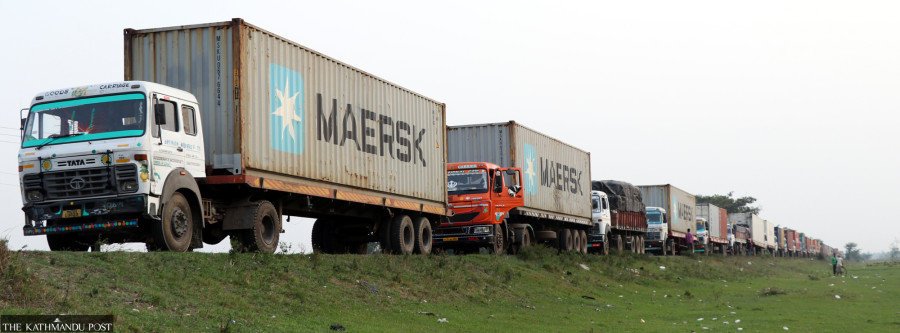Money
Consumer prices likely to rise on higher container shipping rates
A global surge in freight charges could raise consumer prices by 2.2 percent in the least developed countries, UNCTAD says.
Krishana Prasain
There's more bad news for Nepalis already beset by inflation: They can look forward to another year of rising prices, say insiders. The United Nations Conference on Trade and Development (UNCTAD) has predicted that higher shipping costs will make goods costlier over the next year.
According to the UNCTAD report published on November 18, the global surge in container shipping rates could raise consumer prices by 2.2 percent in the least developed countries (LDCs) over the next year, based on an 8.7 percent increase in import prices.
The report says sustained high rates are already affecting global supply chains. The jump in container freight rates can slow national economies, particularly the structurally weak ones such as small island developing states, least developed countries and landlocked developing countries—whose consumption and production patterns are highly trade dependent.
Shipping costs are a key component of food and non-food prices in countries like Nepal.
The steep rise in container freight rates will add to production costs, and this burden is ultimately passed on to the consumer.
Container freight rates skyrocketed amid a surge in demand for freight transport, shortage of shipping containers, and limited capacity and congestion at ports, the report said, adding that the impact was generally greater in smaller economies.
While the global inflation rate was 2.8 percent last year, consumer price inflation in the LDCs was 22.4 percent, as per the report.
Prices of the top 10 products are expected to increase from 6.4 to 11.4 percent, the report said. Computers, electronics and optical products will become costlier by 11.4 percent, while prices of textiles, clothing and leather products are estimated to increase by 10.2 percent.
Electrical equipment, other transport equipment and motor vehicles, trailers and semi-trailers will become more expensive by 7.5, 7.2 and 6.9 percent respectively. Prices of basic pharmaceutical products and pharmaceutical preparations will increase by 7.5 percent, the report said.
Nepal is highly dependent on imported goods. As a result, the country’s foreign exchange reserves have been receding as it has had to spend more on imports.
According to the Department of Customs, Nepal’s imports ballooned by 61.57 percent to Rs650.29 billion in the first four months of the current fiscal year (mid-July to mid-November). The trade deficit swelled by 56.83 percent during the review period.
In the last fiscal year 2020-21, Nepal’s imports recorded a 28.66 percent year-on-year jump to Rs1.53 trillion.
Exports also soared by 104.29 percent in the first four months with shipments valued at Rs82.12 billion. Imports accounted for 88.79 percent of Nepal's total foreign trade.
Gross foreign exchange reserves shrank by 5.7 percent to Rs1,319.32 billion as of mid-October 2021 from Rs1,399.02 billion in mid-July 2021, according to the central bank. Of the total foreign exchange reserves, reserves held by Nepal Rastra Bank decreased by 8 percent to Rs1,145.29 billion in mid-October 2021 from Rs1,244.63 billion in mid-July 2021.
Imports for consumption are mostly financed by remittance. Remittance earning has also started to drop.
According to the latest central bank data, the amount of money sent home by Nepalis abroad shrank by 7.6 percent to Rs239.32 billion in the first quarter (mid-August to mid-October) compared to a 12.7 percent increase in the same period of the previous fiscal year.
Experts say that a rise in inflation globally was one of the factors behind the drop in remittance because Nepali migrant workers have to spend more on their living expenses, leaving less money to send home.
Trade economist Posh Raj Pandey downplayed price hike forecasts saying that since two-thirds of Nepal's trade is conducted with neighbouring India, the impact of higher shipping costs will be nominal.
“The impact of maritime shipping charges is absorbed by India first, and then it comes to Nepal. So, the rise in shipping charges will not have that much impact on Nepal's economy,” Pandey said.
According to him, a rise in fuel prices has increased consumer prices in Nepal. Exports to third countries will be hit hard due to costlier transportation charges, he said.
Pandey said that goods such as garment, tea and carpet that are exported in third countries will see a negative impact due to a rise in trade costs.
According to experts, shipping costs to the United States have already more than tripled since the pandemic, taking away the ability of Nepali products to compete with goods from neighbouring countries in the American market.
“Because of the high costs, Nepali products cannot compete with those produced in neighbouring countries, so the government should closely monitor the rates and look for solutions to bring prices back to where they were before the pandemic,” Kiran Prakash Saakha, president of the Nepal-USA Chamber of Commerce and Industry, told the Post in a recent interview.
To address high freight rates, UNCTAD has called on governments to monitor markets to ensure a fair, transparent and competitive commercial environment, and recommended more data sharing and stronger collaboration between stakeholders in the maritime supply chain.
The high rates will also impact low-value-added items such as furniture, textiles, clothing and leather products, whose production is often fragmented across low-wage economies well away from major consumer markets; UNCTAD predicts a consumer price increase of 10.2 percent on these.
As per the central bank's inflation expectation survey, a majority of people expect average prices of goods and services to rise by a staggering 11.3 percent over the next year.
Imports of goods and services accounted for 32.83 percent of Nepal's gross domestic product in fiscal 2020-21.




 13.12°C Kathmandu
13.12°C Kathmandu













%20(1).jpg&w=300&height=200)
